
The above photograph of Chris Fitzsimons was taken sometime in the 1960's. Copyright C. Fitzsimons.
an interview with a D.C. Thomson boys and girls comic writer.

The above photograph of Chris Fitzsimons was taken sometime in the 1960's. Copyright C. Fitzsimons.
The following interview with Chris Fitzsimons, a D.C.Thomson’s boys and girls text and picture story writer was conducted by e-mail. CF refers to Chris Fitzsimons. Chris has also kindly provided an example of a script he wrote for the first episode of The Hover Rovers. The script images can be found at the end of the interview below. I have also posted the first episode of The Hover Rovers as it was published in The Hornet.
1) Could you provide a short working biography please?
CF: I wrote in my spare time for Thomson’s. My main career was as a newspaper journalist on various newspapers in Lancashire and Cheshire , and I later become a local government press officer until my retirement.
2) How did you come to work in the comics industry and work for D.C. Thomson’s?
CF: As a schoolboy in the 40s I was an avid reader of Thomson’s four boys’ papers, Wizard, Rover, Hotspur and Adventure, which were filled with purely text stories. In 1957 I sent a short complete story on spec to the Wizard, which was accepted. I was asked to write more over the years, and with the advent of picture-strip papers such as Victor and Hornet I adapted my writing to scripts for them. I was in time invited to write scripts also for the girls’ papers such as Bunty and Mandy.
[Chris remembers only a few titles of the tens of stories he wrote for D.C. Thomson, including The Hover Rovers and Bishops Boffins Ed.]
3) Did you pitch story ideas to the editors or did they provide you with story ideas and then asked you to write X number of episodes?
CF: I sometimes submitted my own ideas but also was asked to develop ideas which were offered to me. The length of the series would become apparent as it evolved, its eventual winding-up being agreed between the writer and the editor.
4) Did you meet the editors in person for this or was the process done via telephone and post?
CF: William Blain, the head of all Thomson’s children’s papers, and no mean writer himself (I was told he was the creator of the famous William Wilson), used to venture forth from Dundee a couple of times a year on a national tour to meet up with his writers on their home turf. He was normally accompanied by one of his editors, and they would invite me out to dinner over which ideas would be discussed and outlines offered to me.
5) Did you ever have to write pictorial strips based on text stories and if so was this easier than starting from scratch?
CF: I can only recall one instance of adapting a prose series I had written for the Wizard (Bishop’s Boffins) to a picture script version for the Hotspur. I suppose this was somewhat easier as the basic idea for the story had already been worked out.
6) How many episodes a week did you write on average? (The artists were drawing on average three pages a week).
CF: For the boys’ and girls’ papers I was writing on average two episodes a week.
7) What was the relationship between a writer and a comics editor? For example, a writer having written his scripts sends them in to the editor, would the editor then send those back to the writer that he felt should be amended? Or would this process be done by the editorial staff?
CF: The scripts would be written and sent to the editor one episode at a time (to make sure the story was proceeding in the right direction). If any changes were needed, the editor could sent it back for these, but more often minor changes were made in the office. Occasionally the episode didn’t work at all, so you had to rewrite it.
8) Did you have any say in deciding which artist should illustrate your stories?
CF: The writer had no connection whatever with the artist.
9) Did Thomson's provide you with any 'house' rules on how to write scripts for example, the maximum words in a frame (that is, the characters speaking/thinking and upper and lower panels) and so on?
CF: As with any freelance writing, one studied the market, so I as a writer knew what was needed. The basic rule in writing scripts was, the fewer words the better: let the picture tell the story. The dialogue and captions were there to help the story along. My role was to provide the story and dialogue together with a brief description of each picture. The detail of each frame was left to the sub-editor to spell out for the artist.
10) Did you follow any set rules you set yourself for the writing of scripts and if so can you give us a few examples?
CF: The most important element was pace. The story had to have an arresting start which would lead the reader into the story, and there should be either an upbeat ending or, in the case of a serial, suspense to make the reader desperate to know what happened next. The editors were sticklers for accuracy and believability. There are several versions of a famous story in the business (I think George Orwell made reference to it), dating from the days of the “penny dreadfuls”, about a serial which ended one episode with Jack chained to a chair in a cellar where the water was rising inexorably around him. Unfortunately the writer was knocked over by a bus and was unconscious in hospital. The paper set all its writers to work trying to think of a means by which Jack could escape for the following episode. All failed, and the printer’s deadline was drawing ever closer. At the last minute the writer regained consciousness and a typewriter was rushed to the hospital for him to solve the mystery. He simply asked for a copy of the previous episode, glanced through it, and then began to type: “With one bound, Jack was free...” Thomson’s editors would never fall for that sort of thing!
11) Did you provide scripts for comics outside of the UK, America for example? If so, for which scripts and was the process of writing strips different for other comics?
CF: No. The only comic strip writing I did was for Thomson’s papers (they kept me busy enough).
12) What other professional writing have you done outside of the comics field?
CF: Many years ago I had some plays produced on radio and (in its early days) television. At that time, however, things moved so slowly and would take so many months to come to fruition that I gave it up. By contrast Thomson’s would respond by return of post. (For instance I could post a script to Dundee on a Monday and have a response by the Wednesday or Thursday.) In the 1980s, when it was clear the children’s paper market was declining, and my job was allowing me even less free time, I started writing novels which meant a break away from the tyranny of a weekly cycle. I had two of these books published here and in the US as well as other countries. I have had various articles and stories published in different media over the years.
13) How many other series can you remember writing for D.C. Thomson? Which series are you most proud of and why?
CF: I wrote about 30 series for Hornet, Hotspur and Victor, about 40 series for girls’ papers and several hundred text stories for Wizard and Rover. After all these years it is difficult to pick out a favourite, but one of the most challenging was “Bishop’s Boffins”, which I already referred to: this concerned a group of back-room boys in WW2 who devised new whizz-bang schemes. As author, one had the task of creating a war-winning idea each week!
14) How many Commando scripts did you write? Can you remember any of the titles? Do you have any copies of a Commando script you wrote at all?
CF: I wrote about a dozen Commando books. In those days (before word-processors) carbon copies were the only record one had of one’s work. Indeed the whole business of writing was harder physically than today, with the manual typewriter the only available tool of one’s trade. [One of Chris's Commando books is Carson's Private Army. Ed.]
15) What was the main brief from the Commando editor as regards the writing of a Commando script?
CF: The procedure was to work up an idea and send a detailed synopsis of the story to the editor, who would then commission it (or not as the case might be). This was logical as there was so much work involved in writing a 64-page story that one couldn’t afford the risk of wasting all that time. That said, on one occasion the then editor did commission the script and, after it was delivered, decided he didn’t want it after all. That left me disillusioned as far as Commando was concerned. I don’t think I did any work for it after that.
16) Did you do some research for the Hover Rovers on hovercrafts?
CF: I must have done some research, as one did for most series, but I can’t recall how much. On occasion the editor would provide research material for a particular series. One needs to remember that, before the days of the internet, research could be very demanding work.
17) If you provided scripts for many D.C. Thomson comics you were no doubt happy to provide scripts for just about any genre? Is this correct or would there be some genre's you weren't happy writing about?
CF: I was a journeyman writer. One provided whatever one saw the market was calling for.
18) Were you in the Armed Forces during the Second World War and if so did you make use of your experiences in comic strips?
CF: I grew up during WW2 and was called up into the RAF as a National Serviceman five years after it ended. In fact most schoolboys during the war had a wide-ranging and detailed knowledge of military matters, with fathers or older brothers in the services. In addition the news and entertainment media were dominated by the war, so all aspects of it were covered.
My thanks to Chris for answering my questions.
Below can be found the eleven script pages written by Chris that make up the three page episode of the first Hover Rovers adventure. I've also posted further down the page, how the story appeared when it was published in The Hornet. In addition I have also included several picture adventures of Chris's Bishop's Boffins from the Hotspur comic, 2nd series. I have yet to locate any copies of the text stories about Bishop's Boffins, but once I do, I will post them on this page.
My thanks once again to Vic Whittle for the scans of Bishops Boffins. Please visit his website for information about the D.C. Thomson boys text comics.
Chris mentions about the below scripts - 'I don’t know about other writers, but you will see that I only ever gave a bare description of each picture because (a) I have no visual flair and (b) it would have been extremely time-consuming to attempt it. My job was to provide the story and dialogue and it was for the subeditors to instruct the artist on how to illustrate it.
The script may have some curiosity value in that, while just about readable, it shows the carbon copy script “warts and all” – i.e. smudges where mistakes were made in the typing and had to be corrected on the original top copy with a typewriter rubber. (Those were the days, before Tippex, when writing called for hard physical labour as well!')
 |
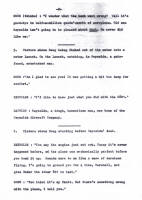 |
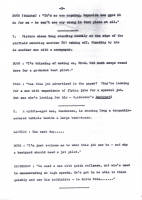 |
 |
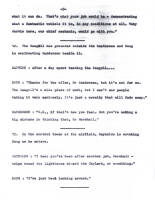 |
 |
 |
 |
 |
 |
 |
You've read the above script, now see how the artist interpreted Chris's story to produce the very first episode of The Hover Rovers. (Not forgetting the editorial teams input into the series). This Rovers story is from the Hornet issue 171, artwork by Farrugia. For further information about this series and the Flying Tiger series (also penned by Chris), please visit the relevant pages via the buttons below.

| 
The Flying Tiger. |
 |
 |
 |
Below are two of the text Boffin stories written by Chris. The stories are from The Wizard 01st April and 22nd April, 1961 respectively. (My thanks to Chris for the scans of both stories). Below that are four picture stories from The Hotspur (second series), featuring Bishop's Boffins. The stories are from issues 670, 671, 672 and 693. The artwork is by Jim Watson.
This World War Two series concerns the adventures of a group of boffins or scientists brought together to invent new schemes to help win the war. The team is led by Lieutenant Commander Bishop.
 |
 |
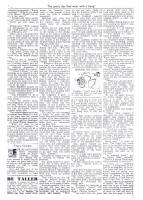 |
 |
 |
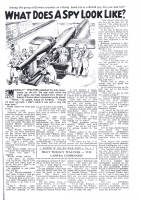 |
 |
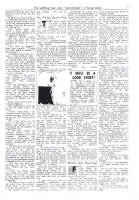 |
 |
 |
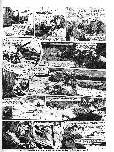 |
 |
 |
 |
 |
 |
 |
 |
 |
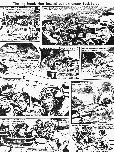 |
 |